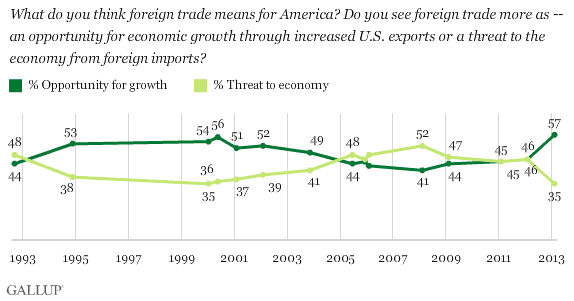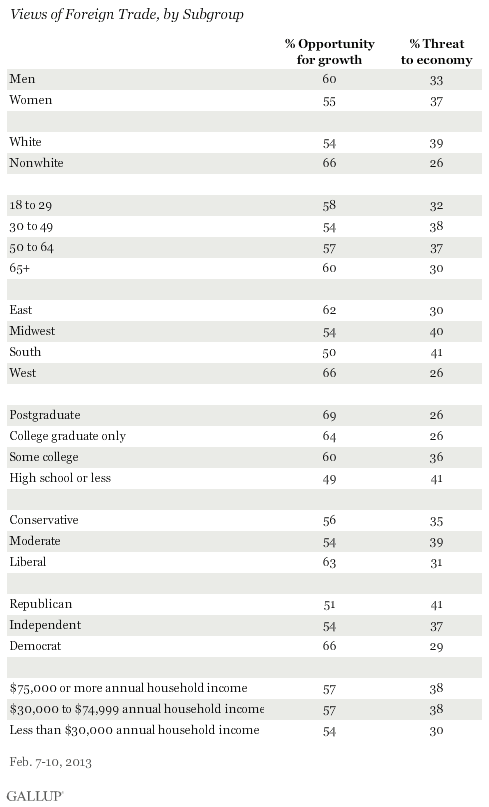PRINCETON, NJ -- Americans now hold a much more positive view of foreign trade than they have in recent years. Fifty-seven percent view trade as "an opportunity for economic growth through increased U.S. exports," while 35% see it as "a threat to the economy from foreign imports." During the prior two years, Americans were evenly divided in their opinions about trade.

The results are based on Gallup's Feb. 7-10 World Affairs poll. Gallup first asked Americans this question about foreign trade in 1992. Over the years, the public's views have shifted, usually in relation to the health of the economy.
- In 1992, as the economy was emerging from a recession, Americans were slightly more negative than positive toward trade.
- As the economy improved from the mid-1990s and stayed strong through the early 2000s, Americans were much more likely to view trade as an economic opportunity than as an economic threat.
- In the latter part of the last decade as well as in the first two years of the current decade, Americans were at best divided in their views of trade. That includes a high of 52% saying trade was more of a threat to the U.S. economy in 2008, during the last recession.
- Now, as the economy has improved in many respects and Americans' economic confidence is as positive as it's been in the last five years, the public has shifted once again toward a positive view of trade.
Those With More Formal Education View Trade Especially Positively
Sixty-nine percent of Americans with postgraduate education view trade as more of an economic opportunity for the U.S., the highest among major subgroups. At the same time, 49% of those with a high school education or less think of trade in this way, one of the least positive assessments of trade among major subgroups.
That 20-percentage-point difference by education is the largest among major subgroups. There are also significant political differences, as 66% of Democrats, compared with 51% of Republicans, view trade as an opportunity for economic growth.

In most major subgroups, significantly more see foreign trade as an economic opportunity than did so last year. However, postgraduates are not one of those groups, because they already mostly endorsed foreign trade in 2012. Rather, it is those with less formal education who have become much more positive about it.
Republicans, Democrats, and independents have shown similar gains in positive views toward foreign trade.

Implications
Americans' views on foreign trade have become much more positive this year, departing from their more skeptical position of the last several years. Americans are now about as positive toward foreign trade as they were during the better economic times of the 1990s and early 2000s.
That means the Obama administration is likely operating in an environment more supportive of U.S. trade deals with other countries than has been the case in the recent past. The Obama administration is currently exploring an ambitious free-trade deal between the United States and the European Union, and continues to work toward a trade agreement with Australia and other Pacific nations.
Survey Methods
Results for this Gallup poll are based on telephone interviews conducted Feb. 7-10, 2013, with a random sample of 1,015 adults, aged 18 and older, living in all 50 U.S. states and the District of Columbia.
For results based on the total sample of national adults, one can say with 95% confidence that the margin of sampling error is ±4 percentage points.
Interviews are conducted with respondents on landline telephones and cellular phones, with interviews conducted in Spanish for respondents who are primarily Spanish-speaking. Each sample of national adults includes a minimum quota of 50% cellphone respondents and 50% landline respondents, with additional minimum quotas by region. Landline telephone numbers are chosen at random among listed telephone numbers. Cellphones numbers are selected using random digit dial methods. Landline respondents are chosen at random within each household on the basis of which member had the most recent birthday.
Samples are weighted to correct for unequal selection probability, nonresponse, and double coverage of landline and cell users in the two sampling frames. They are also weighted to match the national demographics of gender, age, race, Hispanic ethnicity, education, region, population density, and phone status (cellphone only/landline only/both, cellphone mostly, and having an unlisted landline number). Demographic weighting targets are based on the March 2012 Current Population Survey figures for the aged 18 and older U.S. population. Phone status targets are based on the July-December 2011 National Health Interview Survey. Population density targets are based on the 2010 census. All reported margins of sampling error include the computed design effects for weighting.
In addition to sampling error, question wording and practical difficulties in conducting surveys can introduce error or bias into the findings of public opinion polls.
View methodology, full question results, and trend data.
For more details on Gallup's polling methodology, visit www.gallup.com.